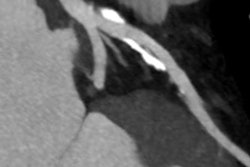
Eagerly awaited figures for the German Cardiac CT Registry show for 7,061 patients examined at 13 centers between 2009 and 2014, reporting was performed by cardiologists in 48% of cases, by radiologists in 4% of cases, and jointly in the remaining cases.
 Before the German registry, large-scale data about cardiac CT did not exist, according to Dr. Stephan Achenbach.
Before the German registry, large-scale data about cardiac CT did not exist, according to Dr. Stephan Achenbach.
"The vast majority of cardiac CT examinations are performed to rule out or detect coronary artery stenoses," noted lead author Dr. Stephan Achenbach, professor and chairman of cardiology at the University of Erlangen in Germany. "With a low average radiation dose, further diagnostic testing -- including invasive coronary angiography -- can be avoided in a high percentage of patients."
The registry includes 13 experienced clinical sites using at least 64-slice CT systems. Next to patient parameters and procedural data, indications and clinical consequences of the test results are recorded in a systematic fashion.
Achenbach, who is vice president of the European Society of Cardiology (ESC), unveiled the latest data at last week's ESC annual meeting in London. As a consequence of the CT result, invasive coronary angiography was avoided in 42% of cases, testing for ischemia was recommended in 5%, invasive coronary angiography in 15%, and a change of medication in 20%.
Among the other key points were:
The mean patient age was 61 ± 12 years, and 63% of the patients were men.
37% of examinations were performed on an outpatient basis, while 63% were carried out on an inpatient basis. Around 91% of exams were scheduled electively and 9% as an emergency.
In 8.9% of cases (630 in total), only coronary calcium imaging was performed. In 16.5% of cases (1,163), only coronary CT angiography was carried out. In 57.3% of cases (4,043), coronary calcium and coronary CT angiography were combined. Other cardiac CT exams were performed for the remaining 16.5% of cases (1,162).
Coronary calcium scoring was performed using prospective triggering in 79% of cases (21% with retrospective gating). A tube voltage of 120 kV was used in 98% of exams, and the mean dose length product (DLP) was 42 mGy* cm (estimated effective dose 0.6 mSv).
Coronary CT angiography was prospectively triggered in 76% of cases (24% with retrospective gating), 100 kV tube voltage was used in 31% of cases, and mean DLP was 256 mGy* cm (dose 3.6 mSv).
Before the registry was established, Achenbach and his colleagues were concerned that data about the indications, acquisition parameters, results, and clinical consequences of cardiac CT were not available on a large scale.
Cardiac CT permits coronary artery visualization to identify coronary calcium and -- after injection of contrast agent -- to detect and rule out coronary artery stenoses, they explained in the background notes for the registry. Furthermore, it allows anatomic and functional imaging of the heart with high temporal and spatial resolution.



















